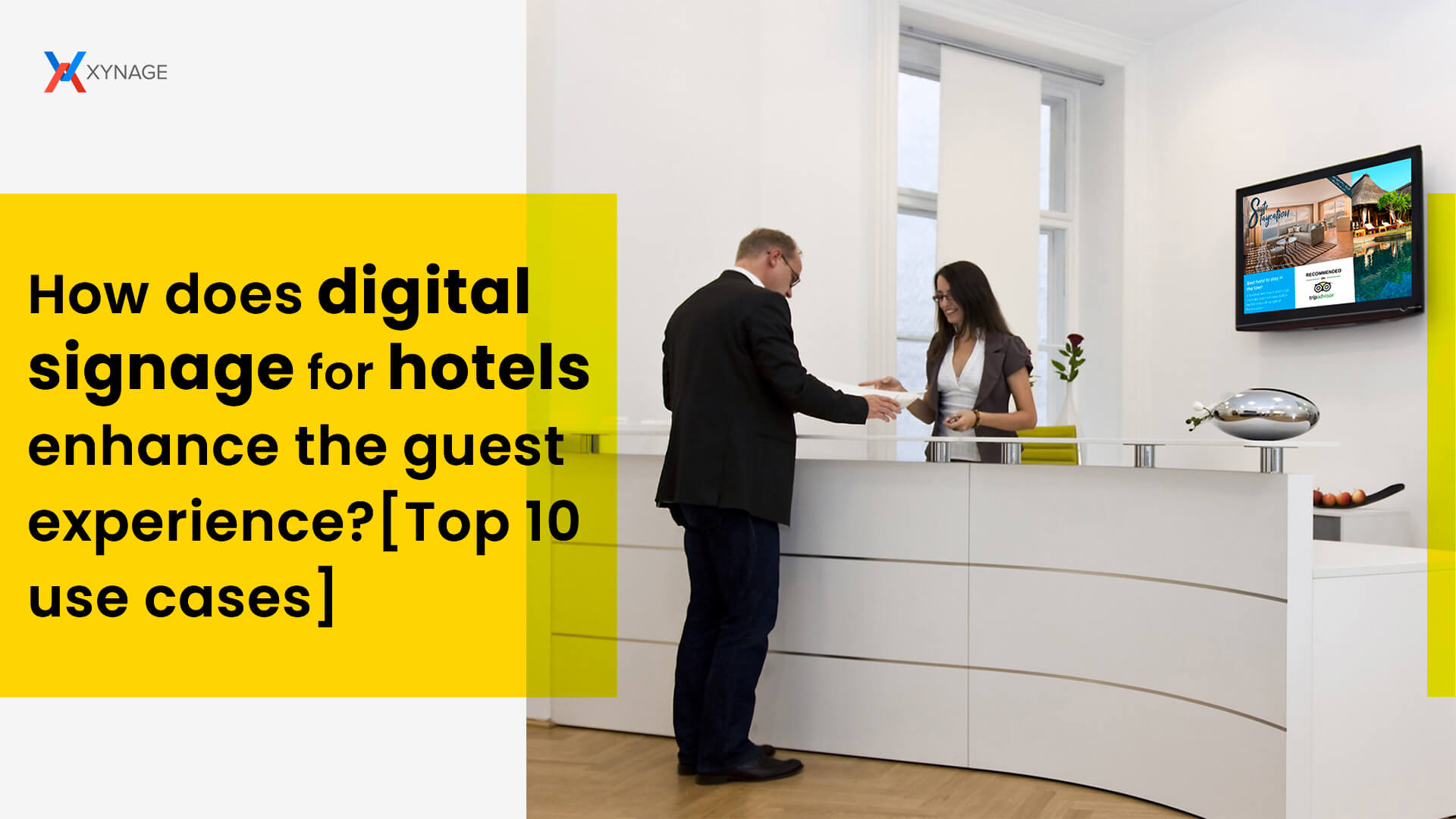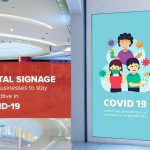If you take a look at the hotels a decade back, you’ll notice TVs only in hotel rooms and probably a single screen in the waiting or reception area.
Now, many hoteliers are striving to bring innovative solutions to their hotel. One of the ways they’re doing this is via digital signage. And they’re doing it to move forward into a new connected hotel space, which means more than just putting a few displays up on the wall.
Today’s travelers are heavily dependent on digital mediums to make their travel experiences more enjoyable. They often have higher levels of technology at home, and they expect the promised a “home away from home” experience to be digitally the same, if not better.
Imagine how they planned their travel. They ordered a taxi from an app, scanned the boarding pass on their smartphone at the airport, went direct to their pre-rented car, and then received alerts to itinerary changes over their smartphones.
By the time your tech-savvy traveler arrives at a hotel, they expect this digital experience to continue.
Top 10 digital signage for hotel use cases
1 – Entertainment
Digital signage for hotel must keep evolving if it is to be useful. Infotainment and news on digital screens were only going to cut it for so long.
Today, guests turn to screens as an origin of relevant, personalized entertainment. With the right broadcast license, hoteliers can also play a film from Netflix in the waiting area.
It could mean adding a YouTube playlist, travel guides, or reviews. When you want hotel guests to stay longer in a hotel bar, restaurant, or lobby, or when you want to reduce their perceived wait time, entertaining digital content is the way-to-go.
2 – Advertisement
You can use the screen partition feature to play ads and show useful content alongside. Moreover, advertisers receive high returns on view rates.
Playlist scheduling or split-screen are two ways to do this. The former allows you to schedule useful and engaging content mixed up with ad displays from sponsors. In the latter, you can use zoned screen displays to pair ad content alongside real information.
Hoteliers also have the benefit of being able to make advertising content more valuable. Local bars, restaurants, and attractions can place advertisements on digital signages to share information, directions, and offers to hotel guests.
3 – Emergency response tool
Digital signage is a fantastic emergency response tool. In case of an incident, guests can be warned by sending out messages across all screens with a click of a button.
This is a quicker and more efficient public way to get every guest within the hotel to recognize a potential hazard or danger.
Such messages can be blended with audio to reach those with limited sight or hearing capability. Notices can be arranged in advance or can be written, uploaded, and delivered on the spot.
Digital signage is a network with multiple applications, such that in an emergency, it can become your most essential communication tool.
4 – Travel information
When we are traveling, time is often of the essence. This means that travel delays can be awful and can demolish even the most well-organized plans.
Digital signage hotel solutions can share real-time travel updates, which can make a massive difference to the guest experience.
Guests can view live travel updates from nearby trains, trams, and subways, and more. Based on this data, they can organize their plans much more efficiently.
5 – Wall art
While digital screens are high at providing information, we should not ignore their function as flexible art displays. In the healthcare sector, digital wall art is being used to spur better health and reduce nerves.
Within a restaurant, bar, or ambient space, digital displays are a great way to create a distinct look and feel that will set the scene for the guests.
Their flexible nature means you can develop seasonal displays, turn your walls into a unique setting, depending on who is in the hotel at that time. You can also change the look and feel of your digital signage space as often as you like.
6 – Personalized virtual concierge service
The idea of the concierge services in hotels is that you get any information you may require instantly. But the concierge has always been only human.
As much as they cram up, you could still ask questions, for which they do not have answers. When you introduce a digital screen, both the guest and the concierge, have the data they need at their fingertips.
It also implies that the right person should be on hand at all times to answer questions. Hoteliers do not have to bother about break times or having a concierge with distinct expertise because the digital screen has it all.
7 – In-room services
Many hotels still use traditional digital signage techniques to please their guests showing a “Happy Anniversary” or “Happy Birthday” or “Welcome to the hotel” sign.
Hotels still using these outdated, irrelevant displays are missing an opportunity. With the rise of cloud-enabled digital signage solutions, every display in the hotel can be controlled from a centralized system.
This makes grouping displays and applying modifications to them all simultaneously, quite easy. On the other hand, personalization is far more feasible.
For example, wouldn’t it be more appealing if, on entering the room, the guests saw a personalized welcome message, hotel’s Instagram feed, latest headlines, and live dashboard of travel information?
8 – Welcoming guests
A fantastic guest experience demands engagement, but taking each client through the list of selling points might take a while. On peak days, digital signage becomes a helping hand for staff members.
Real-time welcome information showed on the screen could include check-in wait times, local travel updates, restaurant opening hours, and even offers or upgrades available. While customers are waiting for a taxi, or to check-in, they get prime viewing seats on everything the hotel has to offer.
9 – Frequently asked questions
Hotel digital signage screens are a fantastic way to present the most frequently asked questions by customers and answer them before they ask the hotel staff.
This can include everything from breakfast schedules to pet policies to hotel check-out time displays. Posting such content in a question and answer format guarantees that at least some of the guests will be helped before engaging a staff member.
10 – Automated check-in
Check-in is undoubtedly a pain point in the hotel visitor journey. If you can make your digital displays both useful and entertaining, inevitably, this reduces negativity associated with that vital first impression?
Assume that a visitor has entered your hotel. His eye is naturally drawn to the digital display on the wall. Of course, the guest knows he can use the regular check-in desk if he wants to, but he will use the screen to check-in instead because of the long queues.
Verdict
The possibilities for hotel digital signage are immense. It creates an avenue to uplift the guest experience, reinforces the brand, improves staff efficiency, and drives additional profit. With digital signage solutions, the improvement is instantaneous, delivering a strong ROI.
Digital signage for Hotel – General FAQs
1) How much does digital signage cost?
Digital signage for hotels costs quite less than static displays. A digital signage solution like Xynage can cost you about $1000 per location.
2) What are some of the notable benefits of digital signage for hotels?
The five most significant benefits of digital signage for hotels are:
- Higher retention rate
- Increase in revenue
- Digital Connectivity
- Reduces operational cost
- Easy to deploy
3) Which digital signage software is best for my hospitality business?
Xynage is one of the most prominent digital signage software and hardware services providers. It runs on the Android Operating System and comes with a stand-alone device that connects with your screen.
4) What perks do I get with Xynage – digital signage solutions?
You can add HD videos, social media feeds, scrolling images, multimedia slideshows, YouTube playlist, tickers, and more.



